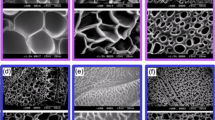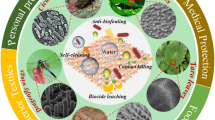Abstract
Durable superhydrophobic surface on cotton fabrics has been successfully prepared by sol–gel method. Cellulose fabric was first coated with silica sol prepared with water glass and citric acid as the acidic catalyst. The silica coated fabric was then padded with hydrolyzed hexadecyltrimethoxysilane afterwards obtaining low surface energy. Water contact angle and hydrostatic pressure were used to characterize superhydrophobicity and washing durability. Scanning electron microscopy was used to characterize the surface morphology changes after certain washing times. All results showed good durable hydrophobicity on cellulose fabrics. In addition, the influence of citric acid and sodium hypophosphite (NaH2PO2) on the durability of hydrophobicity was also investigated. The durability of treated cotton improved with the increase of concentration of citric acid in the presence of NaH2PO2. It could be concluded that citric acid acted as multi-functional heterogeneous grafting chemicals to improve washing durability of hydrophobicity by forming the ester bonds between cotton fabric and silica sol and improved the durability of hydrophobicity.





Similar content being viewed by others
References
Guo ZG, Liu WM (2007) Biomimic from the superhydrophobic plant leaves in nature: binary structure and unitary structure. Plant Sci 172:1103–1112
Xue CH, Jia ST, Chen HZ, Wang M (2008) Superhydrophobic cotton fabrics prepared by sol–gel coating of TiO2 and surface hydrophobization. Sci Technol Adv Mater 9:1–5
Li SH, Zhang SB, Wang XH (2008) Fabrication of superhydrophobic cellulose-based materials through a solution-immersion process. Langmuir 24:5585–5590
Taurino R, Fabbri E, Messori M, Pilati F, Pospiech D, Synytska A (2008) Facile preparation of superhydrophobic coatings by sol–gel processes. J Colloid Interface Sci 325:149–156
Li XM, Reinhoudt D, Crego-Calama M (2007) What do we need for a superhydrophobic surface? A review on the recent progress in the preparation of superhydrophobic surfaces. Chem Soc Rev 36:1529
Vilcnik A, Jerman I, Vuk AS, Kozelj M, Orel B, Tomsic B, Simonic B, Kovac J (2009) Structural properties and antibacterial effects of hydrophobic and oleophobic sol–gel coatings for cotton fabrics. Langmuir 25:5869–5880
Yu M, Gu GT, Meng WD, Qing FL (2007) Superhydrophobic cotton fabric coating based on a complex layer of silica nanoparticles and perfluorooctylated quaternary ammonium silane coupling agent. Appl Surf Sci 253:3669–3673
Wang HX, Fang J, Cheng T, Ding J, Qu LT, Dai LM, Wang XG, Lin T (2008) One-step coating of fluoro-containing silica nanoparticles for universal generation of surface superhydrophobicity. Chem Commun. 877–879
Li ZX, Xing YJ, Dai JJ (2008) Superhydrophobic surfaces prepared from water glass and non-fluorinated alkylsilane on cotton substrates. Appl Surf Sci 254:2131–2135
Yang H, Deng Y (2008) Preparation and physical properties of superhydrophobic papers. J Colloid Interface Sci 325:588–593
Latthe SS, Imai H, Ganesan V, Rao AV (2009) Superhydrophobic silica films by sol–gel co-precursor method. Appl Surf Sci 256:217–222
Xue CH, Jia ST, Zhang J, Tian LQ (2009) Superhydrophobic surfaces on cotton textiles by complex coating of silica nanoparticles and hydrophobization. Thin Solid Films 517:4593–4598
Sequeira S, Evtuguin DV, Portugal I, Esculcas AP (2007) Synthesis and characterisation of cellulose/silica hybrids obtained by heteropoly acid catalysed sol–gel process. Mat Sci Eng 27:172–179
Daoud WA, Xin JH, Tao XM (2006) Synthesis and characterization of hydrophobic silica nanocomposites. Appl Surf Sci 252:5368–5371
Roe B, Zhang XW (2009) Durable hydrophobic textile fabric finishing using silica nanoparticles and mixed silanes. Textile Res J 79:1115–1122
Textor T, Mahltig B (2010) A sol–gel based surface treatment for preparation of water repellent antistatic textiles. Appl Surf Sci 256:1668–1674
Daoud WA, Xin JH, Tao XM (2004) Superhydrophobic silica nanocomposite coating by a low-temperature process. J Am Ceram Soc 87:1782–1784
Xing YJ, Yang XJ, Dai JJ (2007) Antimicrobial finishing of cotton textile based on water glass by sol–gel method. J sol–Gel Sci Technol 43:187–192
Hernandez-Padron G, Rojas F, Castano VN (2004) Ordered SiO2-(phenolic-formaldehyde resin) in situ nanocomposites. Nanotech 15:98–103
American Association of Textile Chemists, Colorists (2007) AATCC technical manual. Research Triangle Park, North Carolina
Mahltig B, Bottcher H (2003) Modified silica sol coatings for water-repellent textiles. J sol–Gel Sci Technol 27:43–52
Brinker CJ, Scherer GW (1990) sol–gel science: The physics and chemistry of sol–0gel processing. Academic Press, London, p 106
Hoefnagels HF, Wu D, de With G, Ming W (2007) Biomimetic superhydrophobic and highly oleophobic cotton textiles. Langmuir 23:13158–13163
Leng BX, Shao ZZ, de With G, Ming WH (2009) Superoleophobic cotton textiles. Langmuir 25:2456–2460
Mao ZP, Yang CQ (2001) IR spectroscopy study of cyclic anhydride as intermediate for ester crosslinking of cotton cellulose by polycarboxylic acids. V. Comparison of 1, 2, 4-butanetricarboxylic acid and 1, 2, 3-propanetricarboxylic acid. J Appl Polym Sci 81:2142–2150
Acknowledgments
The research was supported by Shanghai Natural Science Foundation (No. 10ZR1400500) and the Fundamental Research Funds for the Central Universities (No. 2009B03-3-01).
Author information
Authors and Affiliations
Corresponding author
Rights and permissions
About this article
Cite this article
Liu, J., Huang, W., Xing, Y. et al. Preparation of durable superhydrophobic surface by sol–gel method with water glass and citric acid. J Sol-Gel Sci Technol 58, 18–23 (2011). https://doi.org/10.1007/s10971-010-2349-8
Received:
Accepted:
Published:
Issue Date:
DOI: https://doi.org/10.1007/s10971-010-2349-8




